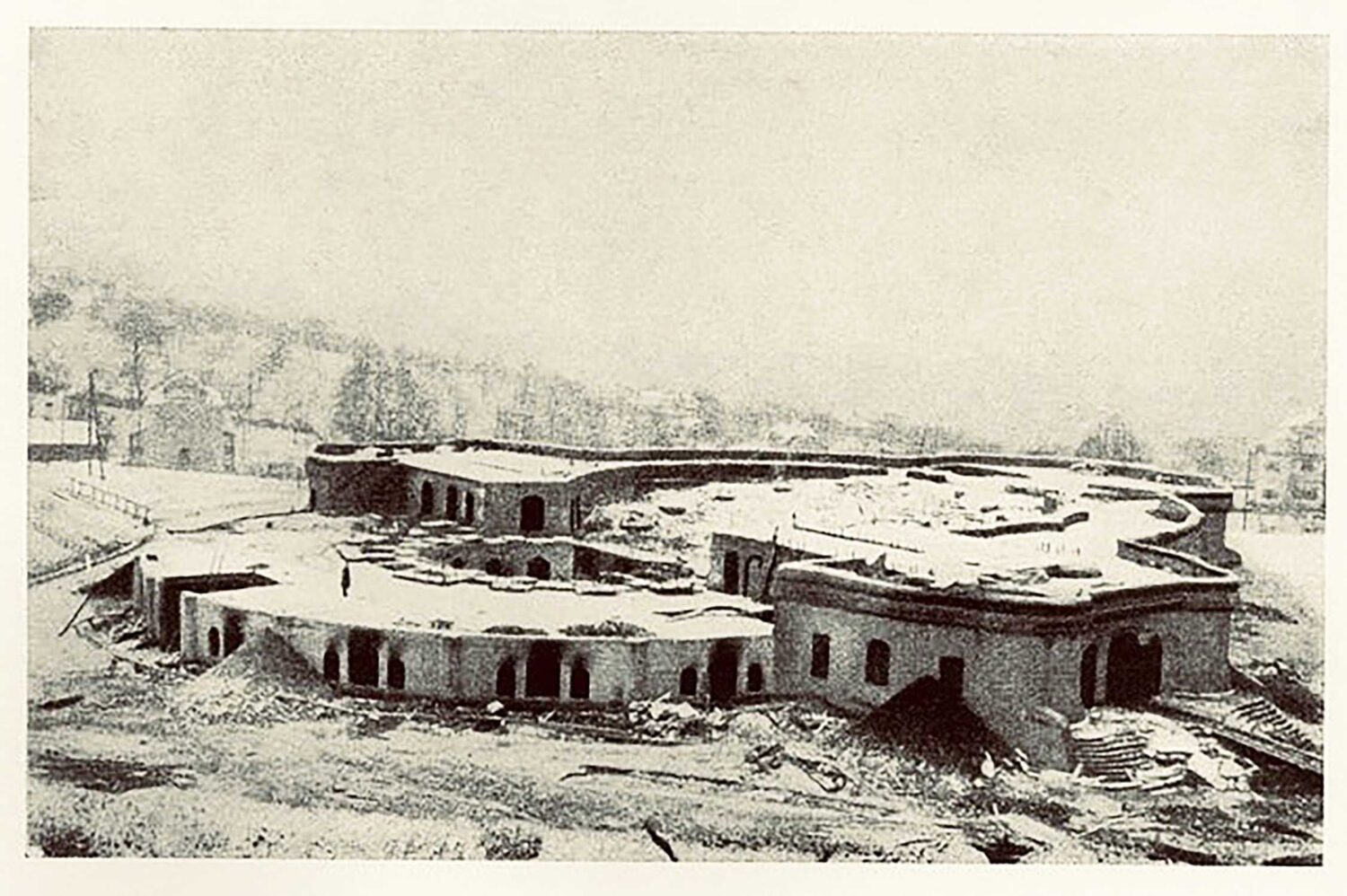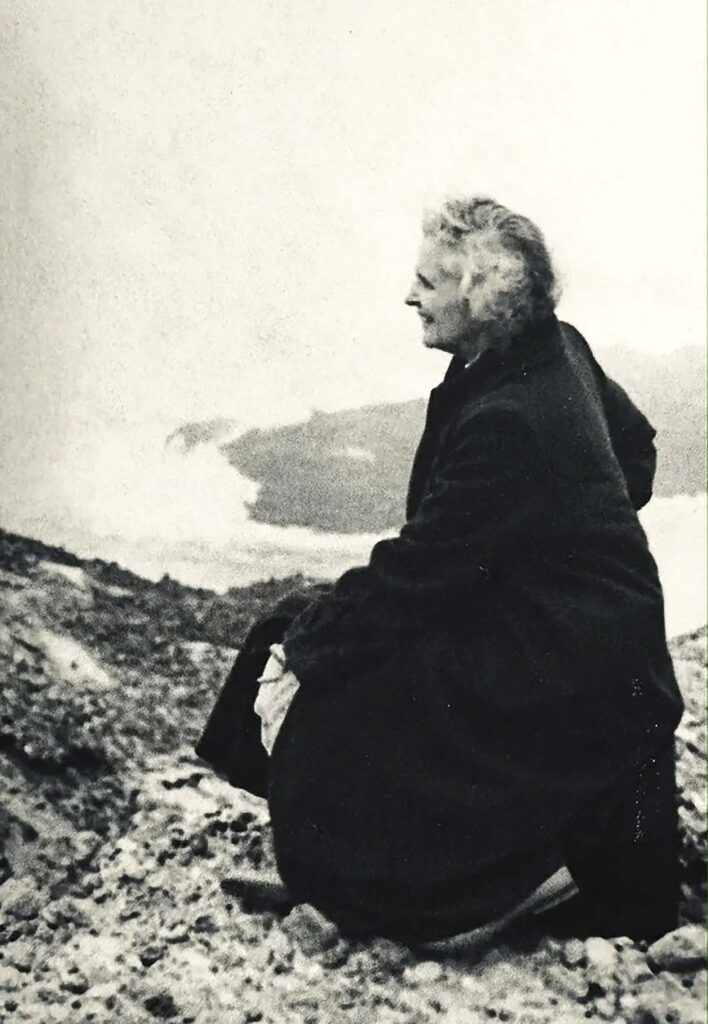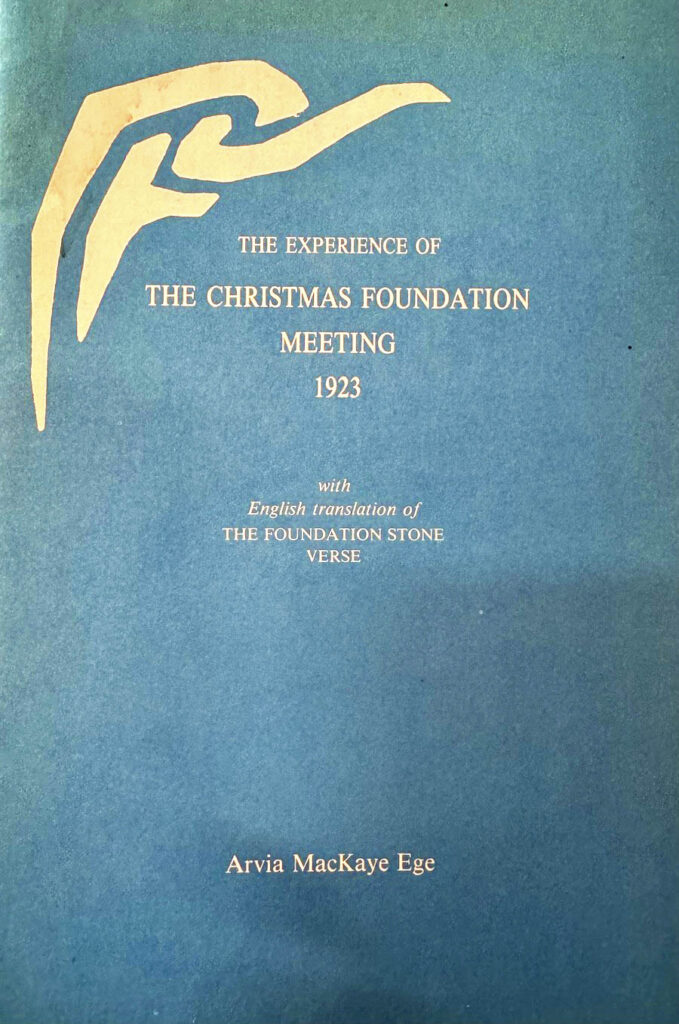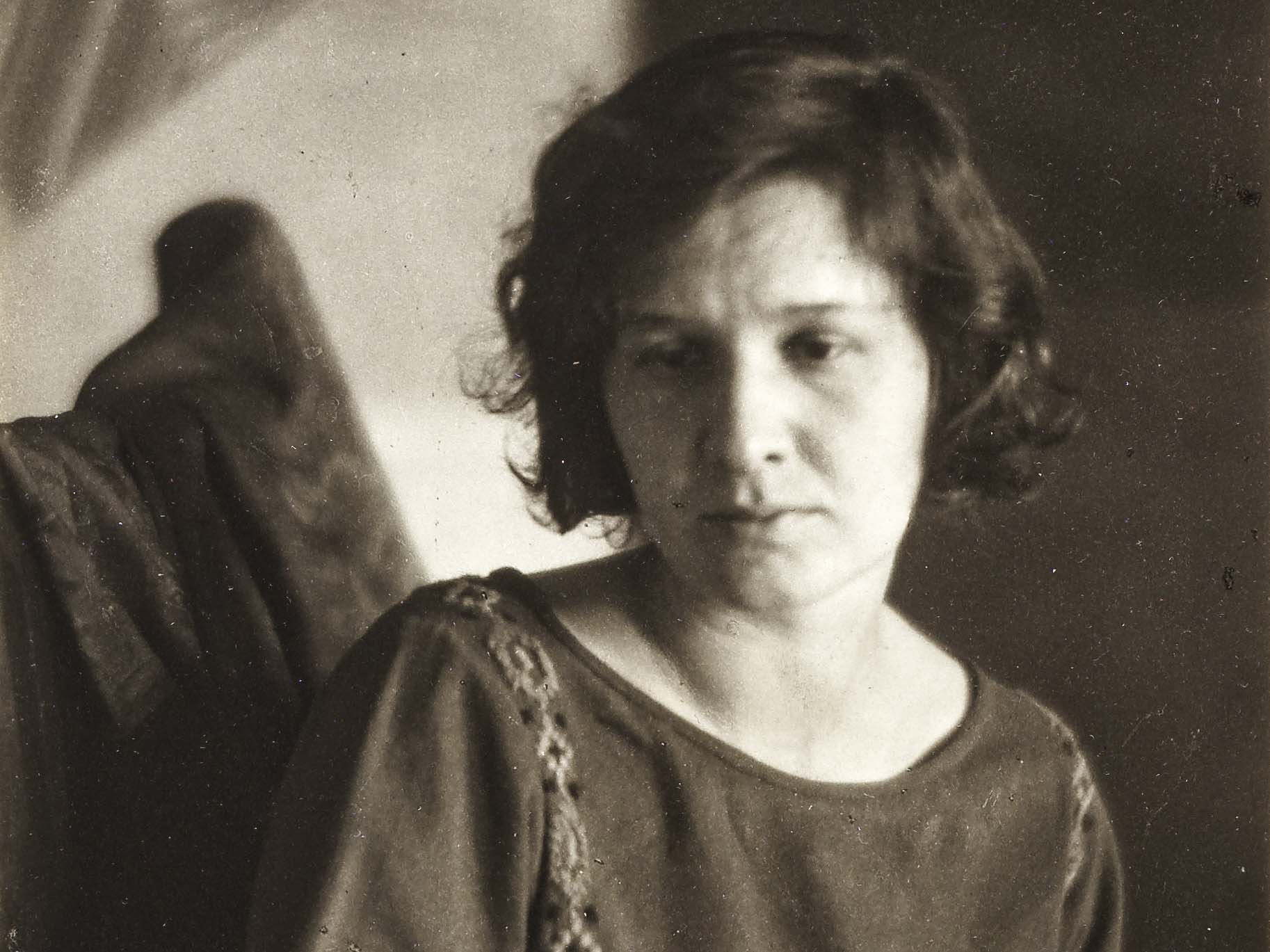Fifty years after the event, Arvia MacKaye Ege recalled the 1923 Christmas Foundation Meeting through the tender, heartfelt memories of her younger self. Now, another fifty years later, we can relive the event again, through her eyes.
When asked to tell something of my memories of the Christmas Foundation Meeting, I can do so only by giving the personal experiences of one who was there as a very young person. They are engraved on my heart among the deepest experiences of my life. And out of the fullness of those days, I shall attempt to give a few pictures …
The Dornach hill in deep snow. Brilliant, starry nights. Cold, sparkling, clear days. The ruins of the Old Goetheanum—the gray, charred concrete lower structure, partially swept by drifts, a gaunt, mute reminder of the tragic night one year ago. Behind the ruins and just above them on the hill, the low wooden barracks of the Schreinerei, the carpentry shop. Here, during the days prior to the Christmas Conference, intense activity had been going on. The walls of the small auditorium, situated in part of this building, were being ripped out on two sides to open the hall toward the adjoining outer workshops. In this way it was hoped that the many people—some coming from distant parts of the world—who had sent word that they were arriving for the Conference, would be able to see and, in any case, to hear. No one had anticipated such a large number. There was an atmosphere of intense expectation and preparation. Then overnight people began to arrive.

On [December] 24th, long processions came climbing up the hill through the snow, past the ruins, along the winding paths that mount steeply from the valley below. All converged upon this small weatherbeaten door of the carpentry shop. Inside, the auditorium and adjoining workshops gradually became packed to overflowing as the people streamed in. Tightly placed chairs filled every bit of available floor space, the stage as well. People sat upon piles of planks in the background, on work benches and anything they could find. It was impossible to heat the whole enlarged space adequately in the bitter cold, and especially out in the farther areas people sat wrapped in heavy overcoats and blankets. Young people were asked to give their seats to the arriving visitors, so many of us stood along the walls at the rear, or perched upon window ledges.
Finding myself near a big machine for sawing lumber, I eagerly clambered up onto it and found myself a somewhat precarious seat on a small metal slab. From it, I was fortunate enough to be able to look out over the heads of the assembled people to the small speaker’s stand placed at the far end of the auditorium from which Rudolf Steiner was to speak. This perch, being suitable only for a young climber, I was fortunately able to keep throughout the Conference. A sense of profound earnestness, of almost breathless expectation and high festivity pervaded the gathering. There seemed to be so much going on in the way of last-minute preparations. Then, at 10a.m., Rudolf Steiner stepped to the podium. The calm, moving dignity of his frail form, clad in black, against the blue curtains, the power and erect carriage of his head, the profound kindness and gravity of his features—the unforgettable depths of his gaze—rise once more in memory. For a long moment he stood silent, as was his custom before he spoke, an enormous quiet surrounding him. Then his deep voice sounded, and with a few simple, impressive words he pronounced the opening of the Christmas Conference, welcoming all who were present.
He spoke first of all, of the special significance of the fact, which should not be forgotten, that the Goetheanum and the centre of the Society had been established upon Swiss soil. And with warm words he now asked Albert Steffen, “our dear and honoured friend”, to be the first speaker. Herr Steffen, the Swiss poet, then spoke on “The History and Destiny of the Goetheanum”, giving, as a sort of prologue to the Conference, a revealing picture of the outer and inner reality of that great building with its high columns, carved capitals and architraves and coloured windows, which had so recently passed through fire. Then, at 11:15 Rudolf Steiner gave the opening address for the foundation of the Society in a new form, which he began with these words: “We begin our Christmas meeting for the foundation of the Anthroposophical Society in a new form in the presence of a sharp contrast. We have had to invite you here, my dear friends, to a heap of ruins! These ruins are in many ways a symbol not only for the outer aspects of our work and striving in the world, but they are symptomatic today for world conditions at large.” (How ever more deeply true these words have become after fifty years!)

“You sit here,” he said, “in this provisional wooden structure which we have had to enlarge overnight; in this poor house, this terribly meager home, in the midst of the ruins. Many of you have to suffer bitterly from the cold. But the more we can find our way into the mood and realization that all this outer world that surrounds us is Maya—illusion—the more we will be able to develop that strong, active mood which will be needed for the coming days. … A revelation of the spirit has opened itself to humanity. Not out of any earthly, arbitrary action, but in obedience to a call which has sounded forth from the spiritual worlds … has the impulse for the Anthroposophical Movement flowed. This Anthroposophical Movement is not an earthly service. It is in its totality, right into all its details, a Divine service. And we will find the right inner mood to approach it, if we behold it in its whole scope and entirety as such a Divine service. As such, let us take it into our hearts at the beginning of this Christmas Conference. Let us write deeply into our hearts that this Anthroposophical Movement seeks to unite the soul of every single one who devotes himself to it with the primordial springs of all that is essentially human in the spiritual world; that it wants to guide the human being to that ultimate—and for him, in the present stage of human evolution on earth—satisfying illumination, which can clothe itself in the words: ‘Yes, that am I as man, as spirit-willed man on earth, as God-willed man in the universe’.”
After these words Rudolf Steiner continued by giving the principles of the new Society and by appointing the members of the Vorstand. Who were these personalities? I will attempt to give a brief characterization of them, as I remember them at that time. Rudolf Steiner, that unique human being I have already attempted to describe, who in assuming the presidency of the Society as its founder, selflessly took upon himself its future destiny together with the destinies of its members. Albert Steffen, with impressive head and shoulders, eagle-like nose, unusually clear, quiet eyes and sensitive mouth, whom Rudolf Steiner designated as a co-founder of the Society—one who had been an anthroposophist before he was born—“the exceptional poet, whose presence in our midst we must look upon as the greatest good fortune”. Guenther Wachsmuth, an eager, alert scientist, then only in his early thirties, an extremely swift, energetic, executive young man—blond, lithe, like a young Hermes. Frau Marie Steiner, that beautiful, so extraordinary and dramatic figure about whom there was a spell of mystery, and without whose gifts and tremendous work the development of the artistic work and the early growth of the Society are unthinkable. Frau Dr. Ita Wegman, a rather tall, active, warm, and in some ways seemingly plain woman, with strangely expressive and arresting eyes—a dedicated medical doctor—about whom there seemed to hover an atmosphere of something heroic as she strode along. Frl. Dr. Vreede, a small compact person whom one could immediately imagine—as Rudolf Steiner himself put it—crossing every t and dotting every i she ever wrote. Today we ask, what was Rudolf Steiner preparing for the future through choosing these individualities as the founding Vorstand; how are we connected with them and interwoven in the great drama of the Society? For we become ever more deeply aware that this Society is the great Mystery Drama of our modern times—the Goetheanum, the Mystery center of the new Christian Mysteries.
Following this initial gathering and those recurring each morning, there were, in the afternoons throughout the Conference, performances either of the unforgettable Christmas Plays or of eurythmy, and in the evenings Rudolf Steiner’s lectures on World History in the Light of Anthroposophy, a series deeply connected with the backgrounds of the Society. Each day was crowned by the outpouring of the spiritual substance and life which flowed from these lectures given in the evenings. Thus, there was scarcely an unfilled moment throughout the nine days of the Conference.

Then, on the following day, Christmas morning at 10 o’clock, Rudolf Steiner enacted the laying of the Foundation Stone of the General Anthroposophical Society. As he had laid the foundation stone for the Goetheanum building in the earth ten years earlier, he now laid the foundation stone of the new Society in the hearts of its members.
Never had I seen him as he appeared then. There was a light from his eyes, a power and majesty about him which made him give the impression of having grown to a great size—an intensity and activity, united with a cosmic calm, which was breath-taking, indicative of what was to come. He opened this event by giving three strong, incisive, measured raps with a gavel upon the speaker’s stand, such as those given in the Temple in the Mystery Plays. It was as though the room became thronged with unseen spectators. Then as he spoke, speaking for the first time the words of the Christmas Foundation Mantram, [the Foundation Stone Meditation], “Soul of Man …,” it was as though he spoke, in this little carpentry shop, not only to the whole earth but to the assembled heavens—as though he became like a sun, light-outpouring, his voice like gold, a Michaelic fire infusing his words. Something poured forth of a magnitude, and in a realm of such awakened consciousness on this Christmas morning, that can only be likened to a spiritual birth.

From my perch in the background, my heart cried out, because I realized that something so far beyond my grasp was taking place that it seemed as if it would burst. Then something gave way within me, and I drank in, like a great tide, all that followed, knowing that only in later incarnations would I approach any adequate realization of what was actually taking place. His words sound over to us again today. Out of these three: the Spirit of the Heights, the Christ-power encircling us, the creative Father-activity streaming out of the depths, we will in this moment form in our souls the twelve-sided Foundation Stone which we now sink deep into the ground of our souls. That morning Rudolf Steiner laid the dodecahedric Foundation Stone into the hearts of all anthroposophists. And from what transpired it was apparent that he did so as a Mystery deed. We sense that this deed, while taking place here on the earth, was enacted on the highest spiritual plane, and as such was a deed that cannot pass away. It is there awaiting us always. And because it was enacted on that plane, it can multiply itself infinitely and become a reality in the heart of each one of us. Thus we are able today to begin to approach it as an archetypal seed sown in humanity—the seed of a free spiritual community of human beings.
Following this Christmas event, each morning throughout the Conference, Rudolf Steiner opened the meetings with the words of the Christmas [Foundation Stone] mantram, dealing with its various rhythms. I remember so well how each day he wrote the verses on a black board set up for the purpose, for everyone to copy. The harmony and beauty of his writing always seemed to me like a starry script—it flowed with such grace, strength and balance.
And now I would like to try to describe a final picture at the end of the Conference. After all that had taken place—the amazing passage of the days, filled with a mood of highest festival and gravity, the deed consummated—would anyone, could anyone, say something in response? And then a figure arose, Herr Werbeck, and did what was in a way impossible, because no one was of course adequate to it. He thanked Rudolf Steiner. It was as though he were the spokesman for all the hearts of those who were there. And, oh, how grateful we were that someone had the courage to do it! And then there followed a picture which is imprinted deep within me as something to be held apart and seldom touched, because it is like a window into a deep mystery. When Herr Werbeck had finished speaking, the frail but majestic figure of Rudolf Steiner bent down—and kissed him. And then, after a long moment, with a scarcely-to-be-fathomed modesty and, at the same time, tenderness, he turned the thanks from himself, directing the gaze of all instead, beyond the ruins to the eternal Spirit of the Goetheanum, in whose name he had spoken and in whose name he now accepted this thanks. This picture is to me like a Mystery picture through which we are allowed to glimpse a great sacrificial deed in the course of human history.
In concluding, perhaps I may recall the following words which Rudolf Steiner spoke during the final lecture, before ending with those timeless verses of the Christmas [Foundation Stone] mantram, and which now sound again strongly in my memory:
“Through all that has transpired here, we will have understood in our hearts, as we pass these ruins, that in the future there will arise spiritual flames which will spring forth as true spiritual life from the re-arisen Goetheanum for the blessing of mankind, which will spring forth through our zeal and through our devotion. The more we are filled with courage, my dear friends, as we leave this gathering—courage for the pursuit of all anthroposophical activity—the better we will have understood what has permeated these meetings like a hope-filled breath of the spirit throughout these days.” The voice admonishing to courage and through courage to awakening—that is what sounds for all anthroposophists in the life of present-day civilization.
This is an excerpt from “The Experience of the Christmas Foundation Meeting, 1923”, in Journal for Anthroposophy (U.S.A.), Autumn 1974















